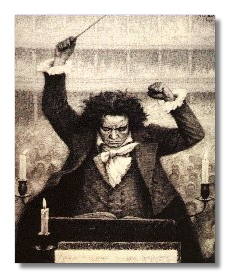
The Internet's Premier Classical Music Source
Ludwig van Beethoven
The Symphonies

Beethoven expanded the traditional sonata-allegro symphonic form (the "classical" form) that depended on symmetry and architecture for its effectiveness. By using the structure of these forms, he evolved a musical language that relies on an increase in, and eventual release of, tension.
The result was a certain conflict between the nominal workings of the forms, and the actual dramatic progress of resulting musical works. The consequences of this approach were the abandonment of the rondo form for symphonic finales, the growth in importance of the second theme of sonata forms, and the eventually the sprawling codas of Gustav Mahler and Anton Bruckner.
- Symphony #1 in C Major, Op. 21 (1800)
- Symphony #2 in D Major, Op. 36 (1802)
- Symphony #3 "Eroica" in E Flat Major, Op. 55 (1803)
- Symphony #4 in B Flat Major, Op. 60 (1806)
- Symphony #5 in C minor, Op. 67 (1807)
- Symphony #6 "Pastorale" in F Major, Op. 68 (1808)
- Symphony #7 in A Major, Op. 92 (1812)
- Symphony #8 in F Major, Op. 93 (1812)
- Symphony #9 "Choral" in D minor, Op. 125 (1824)













